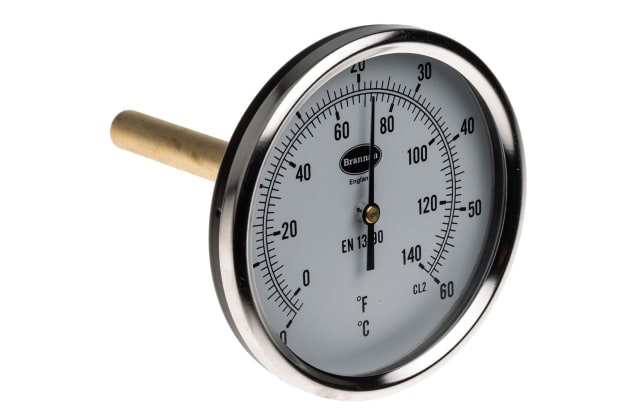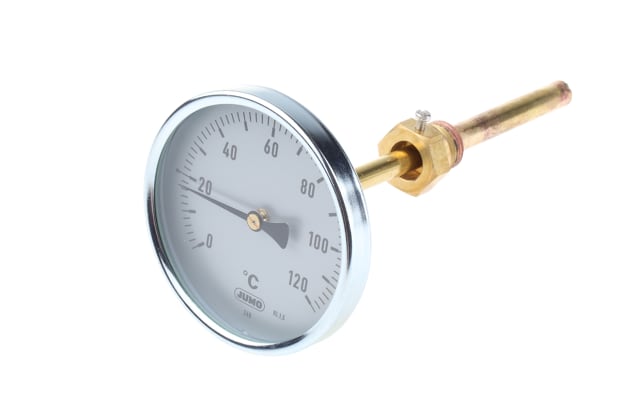- Published 30 Jan 2023
- Last Modified 29 Aug 2023
- 7 min
A Complete Guide to Temperature Gauges
Our temperature gauges guide explores the main types and applications, explains how they work, and answers FAQs.

The purpose of this buyers’ guide is to provide a clear and simple introduction to temperature measurement gauges. We will cover exactly what they are, how they work, and what types are available to buy online in the UK. We will also discuss some of the best uses for a temperature gauge and a digital thermometer in various circumstances.
What is a Temperature Gauge?
A temperature gauge is a device used for the accurate measurement and reading of temperature gradient. The term temperature gauge usually, though not always, refers to a device showing readings on a numbered dial.
Dial thermometer gauges are often found in industrial and commercial settings. They are also common in certain everyday domestic settings and appliances.
Temperature measurement gauges fall into two broad categories - contact thermometers, and non-contact thermometers. People often buy a temperature gauge to help monitor ambient temperatures at the mounting location. These are non-contact sensors.
Certain types of contact temperature gauge are also designed to be coupled with a probe or thermistor. These can then be used to check the surface or inner temperature of an object or medium they are in direct contact with, such as a water temperature gauge.
When people ask what a temperature gauge is, they usually want to know which is the best choice for a specific application. Many people looking to buy temperature gauges online are also keen to learn more about the differences between various models, such as temperature gauges vs. digital thermometers.
Temperature Gauge Types
There are numerous types of temperature gauges for sale online in the UK, including the traditional dial thermometer models. This section will list a few of the most common types and briefly outline some of their key properties and features.
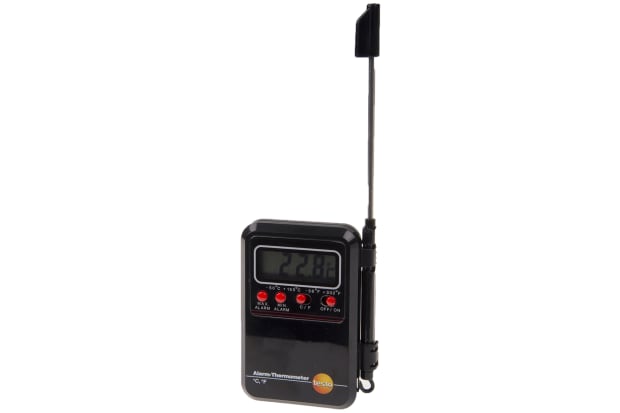
Digital Thermometers
A digital thermometer is a digital temperature gauge that usually shows its readings as a simple numeric display on an indicator or LCD screen. Digital thermometers almost always measure heat levels using some form of probe, attached directly to the body of the device.
The type of probe will determine the best uses for a particular model of digital thermometer. Common examples include resistance temperature detectors (RTDs), thermocouples and thermistors.
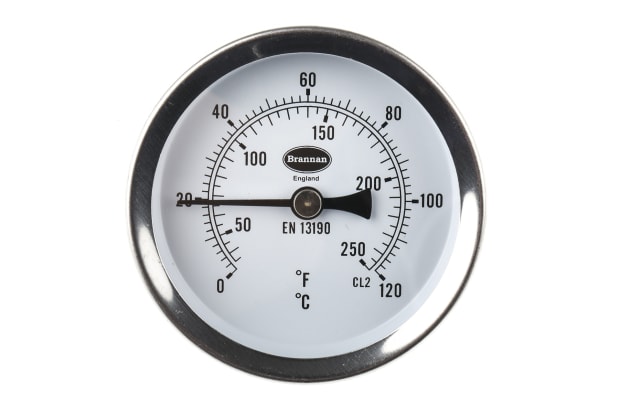
Analogue Thermometers
Analogue thermometers are heat-measuring devices that do not require electricity or battery power. They show temperature readings on a numbered scale or dial. Dials are more common for traditional gauges.
Glass thermometers are made from a transparent tube containing a heat-reactive substance. This expands or contracts alongside a scale, filling the tube as temperature increases. The reactive substance was traditionally liquid mercury, held under pressure in a glass pipe.
The UK has now outlawed the sale of consumer products containing liquid mercury due to its high toxicity. Modern analogue thermometers feature a non-toxic alternative, often in a plastic tube, although they are still often called liquid-in-glass thermometers.
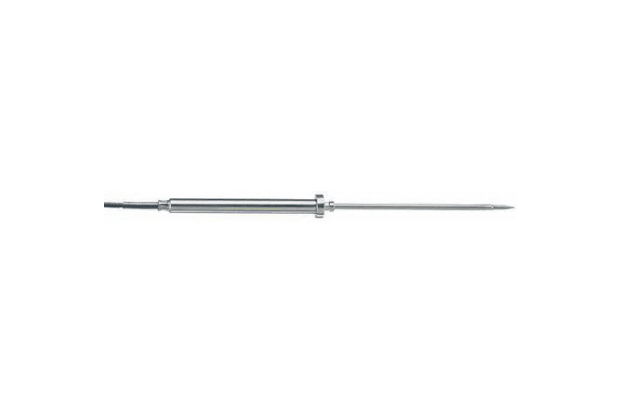
Probe Thermometers
A probe thermometer uses an elongated attachment to contact an object or substance. Examples include a water temperature gauge, a car temperature gauge for monitoring engine coolant or fuel temp, or tools for checking the heat level of a mechanical part.
Different types of probe thermometers can be used for checking surface, interior and immersion temperatures. They are often separate from the main temperature gauge device and attached as an accessory. Thermistor probes are commonly made from stainless steel. You can also buy capillary tube style probes for use as a water temperature gauge.
All types of probe-based temperature measuring instrumentation are available in various mm length and mm diameter measurements.
Temperature Gauge Fixing Types
Many thermometer types, such as medical thermometers and digital temperature sensors, are designed to be portable. Dial temperature gauges are usually small and light enough to move easily when required, but they are often bought for use in a fixed location over an extended period.
You can use many mounting and fixing methods for a standard digital, glass, or dial thermometer. Popular types include steel case clip-on temperature gauges and surface-mount magnetic thermometers. Clip-on thermometers are ideal for many plumbing applications and are often used on pipework and ducting.
In more challenging environments or when working with vibrating machinery, it is often better to avoid surface-mounting the dial mechanism directly. Remote mounting temperature gauges can be read at a distance from the thermistor probe taking the readings, which is attached via a connector to a length of cable or radiator hose.
Temperature Gauge Applications
There are hundreds of potential applications for these products - they are useful wherever you need to monitor and display accurate temperature information.
You will almost always see at least one type of temperature gauge in car dashboards, for monitoring engine coolant temperature. Medical facilities have access to various sorts of body temperature gauge. A water temperature gauge for use on pipes and ducting (including flow and return thermometers) can be found in a professional plumbing toolkit.
You can buy indoor office and commercial room temperature gauges and outdoor air temperature gauges in a huge variety of designs and styles. They can be as small and unobtrusive as a magnetic thermometer for wood stoves, while a heavy-duty industrial temperature gauge, HVAC or expansion temperature gauge will often be much larger and more robust.
High-quality dial thermometers and temperature gauges are manufactured by many leading brands. You will find a diverse variety of models and configurations available online. Some models may also combine other types of digital reader - such as a hygrometer (for humidity), ammeter, auto meter, pyrometer or tachometer - into a single unit.
Some of our most popular brands include Brannan, Gossen Metrawatt, Jumo, and Testo. We also offer our own high-quality in-house range of RS Pro temperature gauges, for cost-effective precision heat measurement.
How Does a Temperature Gauge Work?
Understanding exactly how a temperature sensor works would require knowledge of thermodynamic law. Still, it is important to be aware that different types of thermometers and heat sensors work in different ways. The key to both is the ideal of a bimetal thermometer.
Electronic or battery-powered thermistors, thermocouples and temperature sensors - including digital thermometers - rely on an electrical signal. A digital sensor probe contains two metals (bimetallic), which generate altering voltage or resistance at different temperatures. An onboard heat sensor chip in the device can read these signal changes as accurate heat readings in Fahrenheit or Celsius (often both).
Analogue dial temperature gauges work on a similar principle. However, instead of the heat change generating an electrical signal, it physically alters the positions and properties of small metal components in the instrument sensor. The dial needle is tuned to display these changes as a number value.
Infrared temperature sensors work quite differently again, but these tend to be used in more specialist devices and settings. They are not typically found in standard, low-cost temperature gauges for traditional air or fluid heat measurement.
What are the Symptoms of a Bad Thermostat or Temperature Sensor?
Most types of thermostats and thermocouples have a shelf life. This is because electrical current or physical movement can eventually wear out the metal components of a heat sensor.
Dirt or moisture ingress can also cause problems for certain thermometer types. However, most models designed for outdoor use will be IP rated against this.
A thermostat or temperature gauge not working reliably will need to be tested for accuracy. If you suspect this is the case, the faulty unit may need cleaning, calibration, repair or replacement. In most cases, it is best to contact a qualified engineer for this, particularly when dealing with temperature-critical applications such as sanitary and cleanroom environments, sensitive electronics, food preparation and storage, or industrial and laboratory processes.
